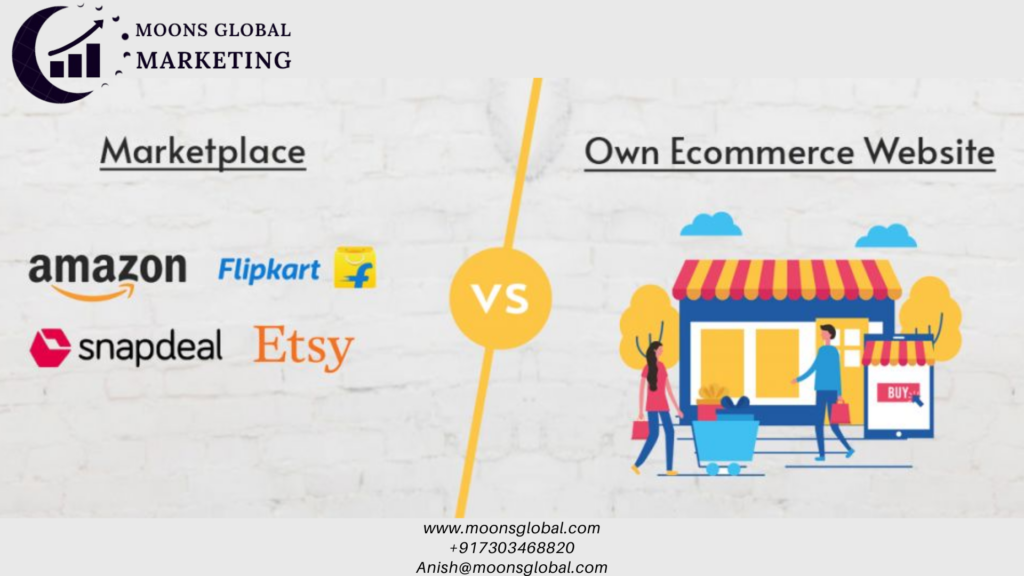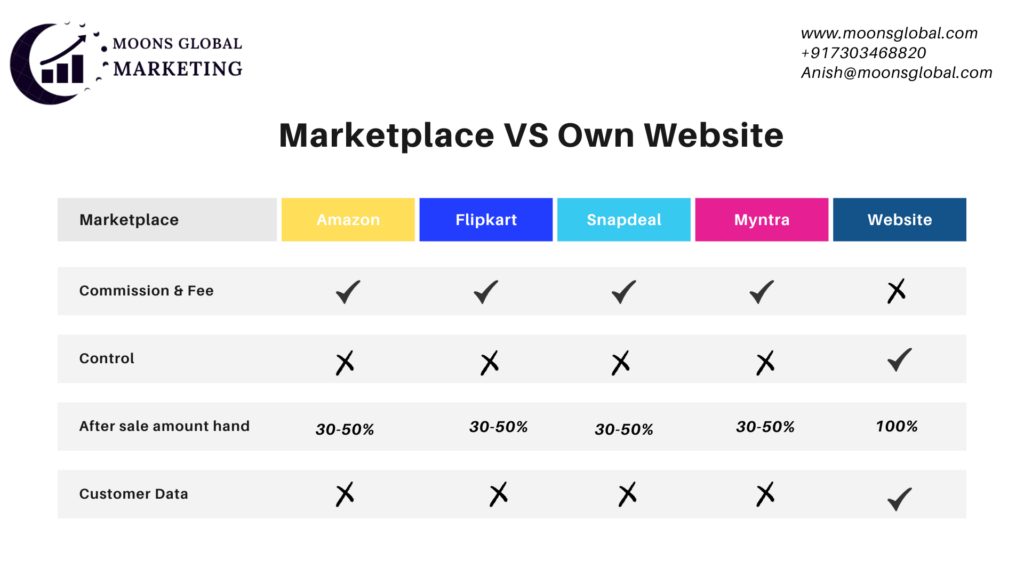
Deciding whether to sell on Amazon Marketplace or through your own website depends on various factors, and each option has its pros and cons. Here are 13 reasons why you might choose not to sell on Amazon Marketplace and why selling through your own website could be a more appealing option:
Reasons to choose Own E-commerce website over Marketplace like Amazon
- Profit Margins on Amazon Marketplace:
- Amazon Marketplace: Amazon Marketplace’s fee structure, including referral fees, fulfillment fees, and other charges, can significantly impact your profit margins. In some cases, total fees may add up to 60% or more of the product’s selling price, especially when utilizing fulfillment services.
- Your Website: Selling through your own website allows you to retain a larger portion of the sale, sometimes 90%. While there may still be costs such as payment processing fees which are just 2%, they are often lower than the cumulative fees on Amazon Marketplace, providing you with more control over your profit margins.
2. Amazon Marketplace Advertising Costs:
One great way for Amazon Marketplace to take away your money.
- Amazon Marketplace: While Amazon Marketplace Advertising can be effective in increasing product visibility, it often comes with significant costs. Competition for ad placements can drive up bidding prices, leading to higher advertising expenditures. Moreover when you get sales you are still paying Amazon Marketplace fess + Advertising Expense.
- Your Website: By selling directly through your website, you have more control over advertising costs. You can implement cost-effective strategies, such as targeted social media ads or search engine optimization, potentially saving on advertising expenses compared to the competitive landscape on Amazon Marketplace.
3. Platform Stability and Policy Changes:
- Amazon Marketplace: Amazon Marketplace’s policies and algorithms can change, affecting product visibility, rankings, and seller performance metrics. I think many of you know that Amazon Marketplace preferred if your product is 300 km radius from the buyer. Can you imagine you cannot cover whole Uttar Pradesh with this Radius. This is just a trick from Amazon Marketplace to convince you to send your product to multiple warehouses.
- Your Website: Operating your website provides more stability and control. You are less vulnerable to sudden policy changes and algorithmic shifts, allowing you to build a more predictable and sustainable business model.
4. Fees and Commissions:
- Amazon Marketplace: Amazon Marketplace charges various fees, including referral fees (percentage of the sale), fulfillment fees (for using Fulfillment by Amazon Marketplace services), and subscription fees (for certain plans like Amazon Marketplace Professional Seller).
- Your Website: Selling through your own website allows you to avoid these third-party fees, providing better control over your profit margins.
5. Brand Control
- Amazon Marketplace: While Amazon Marketplace offers a vast customer base, it controls much of the shopping experience. Your product listings may look similar to competitors, making it challenging to establish a unique brand identity.
- Your Website: Having your own website enables you to control every aspect of your brand, from the design and layout to the product descriptions. This helps in creating a distinct and memorable brand image.
6. Customer Relationships:
- Amazon Marketplace: Amazon Marketplace owns customer data, limiting your ability to establish direct relationships with your buyers. Amazon Marketplace controls communication and might not share customer contact information.
- Your Website: Selling on your website allows you to collect customer data, including email addresses. This data is valuable for building long-term relationships, implementing targeted marketing campaigns, and encouraging repeat business.
7. Customization and Flexibility:
- Amazon Marketplace: Sellers on Amazon Marketplace have limited control over the appearance of their product listings. The templates and formatting are standardized.
- Your Website: Your website provides complete customization options. You can design product pages, optimize the user interface, and create a seamless, branded experience that aligns with your marketing strategy

8. Competitive Environment:
- Amazon Marketplace: With millions of products listed, competition is intense. Also on Amazon Marketplace you can’t do anything to make your brand standout. It is very difficult for new/small brands to do business on Amazon Marketplace.
- Your Website: Operating your website allows you to create a niche market and target specific customer segments. This reduces direct competition and allows you to tailor your offerings to meet the unique needs of your audience.
9. Limited Marketing Control:
- Amazon Marketplace: While Amazon Marketplace has advertising tools, the level of control over marketing strategies is limited compared to what you can achieve on your website.
- Your Website: On your website, you have full control over marketing efforts. This includes implementing SEO strategies, utilizing social media channels, and creating targeted advertising campaigns to drive traffic and sales.
10. Dependency Risk:
- Amazon Marketplace: Relying solely on Amazon Marketplace exposes your business to the risk of policy changes, algorithm updates, or account suspensions that could impact your sales.
- Your Website: Owning your website reduces dependency on third-party platforms. You have more control over your business operations and are less susceptible to external changes that could affect your revenue stream.
11. Up-selling and Cross-selling Opportunities:
- Amazon Marketplace: While there are some cross-selling features on Amazon Marketplace, the opportunities are limited compared to what you can implement on your website.
- Your Website: Direct control over your website allows you to implement effective up-selling and cross-selling strategies, offering related products or accessories during the checkout process to increase the average transaction value.
12. Data Analytics:
- Amazon Marketplace: While Amazon Marketplace provides some basic analytics, the level of detail is limited.
- Your Website: You can use advanced analytics tools like Google Analytics or other e-commerce platforms’ built-in analytics to gather comprehensive insights into customer behavior, preferences, and the performance of your products and marketing efforts.
13. Long-Term Brand Building:
- Amazon Marketplace: Products are often seen as commodities, and it can be challenging to build a lasting brand presence amid intense competition.
- Your Website: Direct sales through your website provide a platform for long-term brand building. You can create a unique story, engage with your audience through blog posts or newsletters, and foster customer loyalty over time.
In conclusion, while Amazon Marketplace provides a massive customer base, the associated costs and limited control can impact your overall profitability. Selling through your own website offers greater control over costs, margins, customer communication, and overall business strategy, providing a more sustainable and potentially more profitable long-term approach. Consideration of these factors should guide your decision-making process based on your business goals and priorities. To know how to start selling on own e-commrece website click here: How to shift sale from Amazon Marketplace to own website
